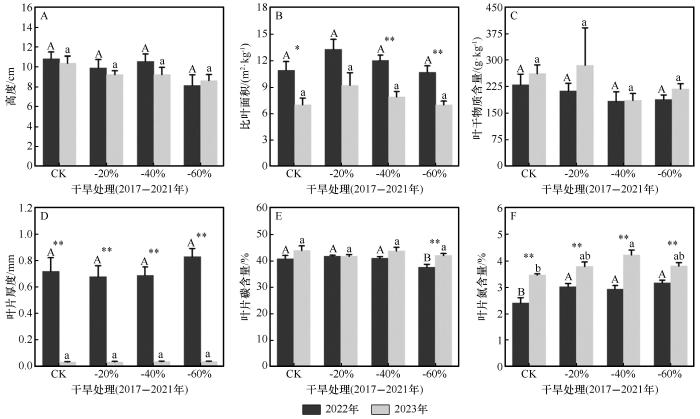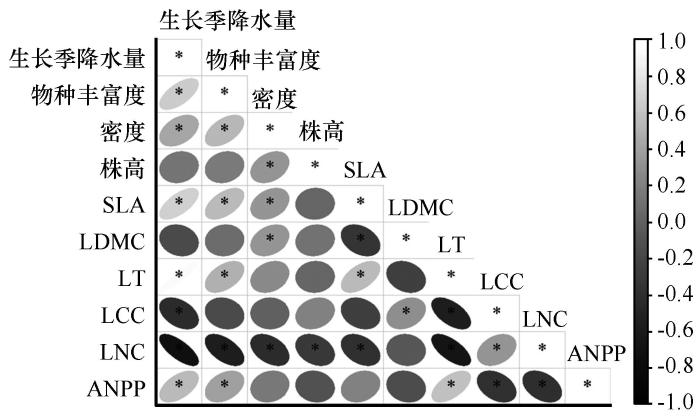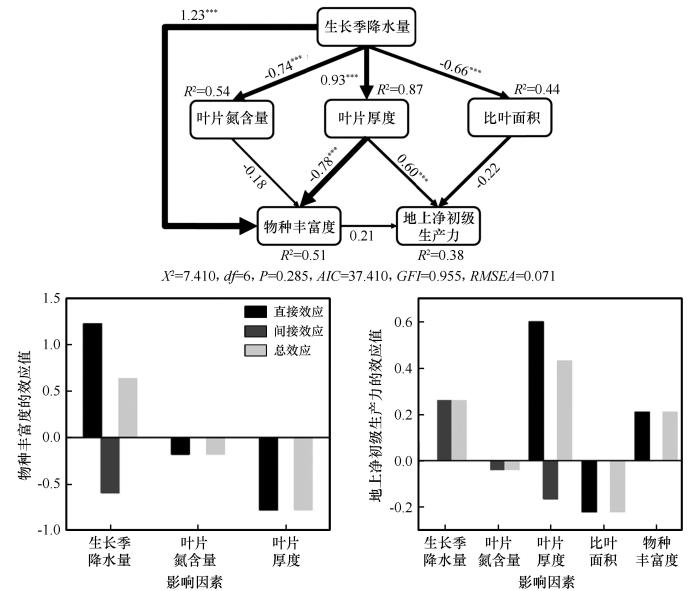极端降水和极端干旱事件对草原生态系统的影响
3
2014
... 降水变化会对干旱草原生态系统的结构和功能产生深远影响[1].特别是随着全球气候变化加剧,干旱事件发生的频率及影响强度预计显著增加,这会加剧干旱草原的水分限制[2],进而改变物种组成[3],降低植物群落的多样性[4]以及生产力[5],损害生态系统功能[6-7].然而,分布于中国干旱半干旱地区的荒漠草原生态系统十分脆弱,对降水变化更敏感[8].因此,深入研究荒漠草原植物群落结构和功能在干旱后的恢复过程,对退化草原的恢复及科学管理具有重要的指导意义. ...
... 相比于年降水量,生长季降水对生态系统的影响更剧烈[16-17],这主要归因于植物的生长繁殖活动等往往集中在降水较多的生长季.生长季降水会影响植物的光合速率、代谢活动以及植物对养分的吸收利用效率等[1],进而影响植物群落水平的结构和功能[18].植物功能性状往往对降水变化更敏感,且能更好地表征群落的周转[19].在干旱恢复过程中,株高、叶干物质含量(LDMC)和叶片氮含量(LNC)等功能性状能够促进草原生态系统群落结构和ANPP快速恢复[20].因此,植物功能性状可能会是预测干旱恢复过程中植物多样性和生产力变化的更好指标.目前,有关干旱恢复过程中植物功能性状如何影响植物多样性和生产力变化的研究仍较匮乏.因此,探讨荒漠草原退化植被恢复过程中生长季降水通过植物功能性状对植物多样性和生产力的影响,有助于了解荒漠草原干旱后的恢复机制,对于生态恢复和实现可持续发展具有重要意义. ...
... 内蒙古荒漠草原是草原向荒漠的过渡带[21],是中国北方重要的生态安全屏障[22].在全球降水变化的背景下,亟须了解荒漠草原生态系统的结构和功能如何响应干旱恢复过程,这对于认识自然生态系统的恢复演变规律和植物的进化过程,预测和减小干旱事件对生态环境和经济发展造成的损失具有重要意义[1].鉴于此,本研究以经5年减雨干旱处理和2年自然降水恢复处理的乌拉特荒漠草原草本植物群落为研究对象,研究荒漠草原植被干旱恢复过程中植物功能性状对植物多样性和生产力变化的影响,能够为退化草地修复、生态系统的保护和可持续发展提供理论依据. ...
Climate-biosphere interactions in a more extreme world
1
2014
... 降水变化会对干旱草原生态系统的结构和功能产生深远影响[1].特别是随着全球气候变化加剧,干旱事件发生的频率及影响强度预计显著增加,这会加剧干旱草原的水分限制[2],进而改变物种组成[3],降低植物群落的多样性[4]以及生产力[5],损害生态系统功能[6-7].然而,分布于中国干旱半干旱地区的荒漠草原生态系统十分脆弱,对降水变化更敏感[8].因此,深入研究荒漠草原植物群落结构和功能在干旱后的恢复过程,对退化草原的恢复及科学管理具有重要的指导意义. ...
Sensitivity of grassland plant community composition to spatial vs.temporal variation in precipitation
1
2013
... 降水变化会对干旱草原生态系统的结构和功能产生深远影响[1].特别是随着全球气候变化加剧,干旱事件发生的频率及影响强度预计显著增加,这会加剧干旱草原的水分限制[2],进而改变物种组成[3],降低植物群落的多样性[4]以及生产力[5],损害生态系统功能[6-7].然而,分布于中国干旱半干旱地区的荒漠草原生态系统十分脆弱,对降水变化更敏感[8].因此,深入研究荒漠草原植物群落结构和功能在干旱后的恢复过程,对退化草原的恢复及科学管理具有重要的指导意义. ...
极端干旱对荒漠草原群落物种多样性和地上生物量碳氮的影响
1
2019
... 降水变化会对干旱草原生态系统的结构和功能产生深远影响[1].特别是随着全球气候变化加剧,干旱事件发生的频率及影响强度预计显著增加,这会加剧干旱草原的水分限制[2],进而改变物种组成[3],降低植物群落的多样性[4]以及生产力[5],损害生态系统功能[6-7].然而,分布于中国干旱半干旱地区的荒漠草原生态系统十分脆弱,对降水变化更敏感[8].因此,深入研究荒漠草原植物群落结构和功能在干旱后的恢复过程,对退化草原的恢复及科学管理具有重要的指导意义. ...
Europe-wide reduction in primary productivity caused by the heat and drought in 2003
1
2005
... 降水变化会对干旱草原生态系统的结构和功能产生深远影响[1].特别是随着全球气候变化加剧,干旱事件发生的频率及影响强度预计显著增加,这会加剧干旱草原的水分限制[2],进而改变物种组成[3],降低植物群落的多样性[4]以及生产力[5],损害生态系统功能[6-7].然而,分布于中国干旱半干旱地区的荒漠草原生态系统十分脆弱,对降水变化更敏感[8].因此,深入研究荒漠草原植物群落结构和功能在干旱后的恢复过程,对退化草原的恢复及科学管理具有重要的指导意义. ...
Global ecosystem thresholds driven by aridity
1
2020
... 降水变化会对干旱草原生态系统的结构和功能产生深远影响[1].特别是随着全球气候变化加剧,干旱事件发生的频率及影响强度预计显著增加,这会加剧干旱草原的水分限制[2],进而改变物种组成[3],降低植物群落的多样性[4]以及生产力[5],损害生态系统功能[6-7].然而,分布于中国干旱半干旱地区的荒漠草原生态系统十分脆弱,对降水变化更敏感[8].因此,深入研究荒漠草原植物群落结构和功能在干旱后的恢复过程,对退化草原的恢复及科学管理具有重要的指导意义. ...
极端干旱对内蒙古温带草原生态系统服务功能和价值的影响
1
2021
... 降水变化会对干旱草原生态系统的结构和功能产生深远影响[1].特别是随着全球气候变化加剧,干旱事件发生的频率及影响强度预计显著增加,这会加剧干旱草原的水分限制[2],进而改变物种组成[3],降低植物群落的多样性[4]以及生产力[5],损害生态系统功能[6-7].然而,分布于中国干旱半干旱地区的荒漠草原生态系统十分脆弱,对降水变化更敏感[8].因此,深入研究荒漠草原植物群落结构和功能在干旱后的恢复过程,对退化草原的恢复及科学管理具有重要的指导意义. ...
降水控制对荒漠植物群落物种多样性和生物量的影响
1
2018
... 降水变化会对干旱草原生态系统的结构和功能产生深远影响[1].特别是随着全球气候变化加剧,干旱事件发生的频率及影响强度预计显著增加,这会加剧干旱草原的水分限制[2],进而改变物种组成[3],降低植物群落的多样性[4]以及生产力[5],损害生态系统功能[6-7].然而,分布于中国干旱半干旱地区的荒漠草原生态系统十分脆弱,对降水变化更敏感[8].因此,深入研究荒漠草原植物群落结构和功能在干旱后的恢复过程,对退化草原的恢复及科学管理具有重要的指导意义. ...
Precipitation drives the floristic composition and diversity of temperate grasslands in China
1
2021
... 植物多样性能够反映植物的群落结构和功能特征[9],研究其变化可以预测植物群落组成对未来降水变化的响应.物种多样性和地上净初级生产力(aboveground net primary productivity,ANPP)是表征草原生态系统稳定性的关键指标[10],对降水变化敏感,干旱会降低荒漠草原物种多样性和ANPP[11].物种多样性和ANPP会随着降水变化而同向变化[12].干旱显著影响草原生态系统,然而关于干旱后荒漠草原生态系统物种多样性和ANPP如何恢复的研究结果仍有较大差异[13-14].草原生态系统的ANPP在干旱后恢复迅速,仅1年时间就与对照无显著差异[14].但也有研究发现干旱的遗留效应会减缓草原生态系统物种多样性和生产力的恢复进程[15].因此,植物多样性和生产力在干旱结束后的恢复还有待进一步探究. ...
Productivity and sustainability influenced by biodiversity in grassland ecosystem
1
1996
... 植物多样性能够反映植物的群落结构和功能特征[9],研究其变化可以预测植物群落组成对未来降水变化的响应.物种多样性和地上净初级生产力(aboveground net primary productivity,ANPP)是表征草原生态系统稳定性的关键指标[10],对降水变化敏感,干旱会降低荒漠草原物种多样性和ANPP[11].物种多样性和ANPP会随着降水变化而同向变化[12].干旱显著影响草原生态系统,然而关于干旱后荒漠草原生态系统物种多样性和ANPP如何恢复的研究结果仍有较大差异[13-14].草原生态系统的ANPP在干旱后恢复迅速,仅1年时间就与对照无显著差异[14].但也有研究发现干旱的遗留效应会减缓草原生态系统物种多样性和生产力的恢复进程[15].因此,植物多样性和生产力在干旱结束后的恢复还有待进一步探究. ...
Drought of early time in growing season decreases community aboveground biomass,but increases belowground biomass in a desert steppe
1
2021
... 植物多样性能够反映植物的群落结构和功能特征[9],研究其变化可以预测植物群落组成对未来降水变化的响应.物种多样性和地上净初级生产力(aboveground net primary productivity,ANPP)是表征草原生态系统稳定性的关键指标[10],对降水变化敏感,干旱会降低荒漠草原物种多样性和ANPP[11].物种多样性和ANPP会随着降水变化而同向变化[12].干旱显著影响草原生态系统,然而关于干旱后荒漠草原生态系统物种多样性和ANPP如何恢复的研究结果仍有较大差异[13-14].草原生态系统的ANPP在干旱后恢复迅速,仅1年时间就与对照无显著差异[14].但也有研究发现干旱的遗留效应会减缓草原生态系统物种多样性和生产力的恢复进程[15].因此,植物多样性和生产力在干旱结束后的恢复还有待进一步探究. ...
Positive linear relationship between productivity and diversity:evidence from the eurasian Steppe
1
2007
... 植物多样性能够反映植物的群落结构和功能特征[9],研究其变化可以预测植物群落组成对未来降水变化的响应.物种多样性和地上净初级生产力(aboveground net primary productivity,ANPP)是表征草原生态系统稳定性的关键指标[10],对降水变化敏感,干旱会降低荒漠草原物种多样性和ANPP[11].物种多样性和ANPP会随着降水变化而同向变化[12].干旱显著影响草原生态系统,然而关于干旱后荒漠草原生态系统物种多样性和ANPP如何恢复的研究结果仍有较大差异[13-14].草原生态系统的ANPP在干旱后恢复迅速,仅1年时间就与对照无显著差异[14].但也有研究发现干旱的遗留效应会减缓草原生态系统物种多样性和生产力的恢复进程[15].因此,植物多样性和生产力在干旱结束后的恢复还有待进一步探究. ...
Resistance and resilience of a semi-arid grassland to multi-year extreme drought
1
2021
... 植物多样性能够反映植物的群落结构和功能特征[9],研究其变化可以预测植物群落组成对未来降水变化的响应.物种多样性和地上净初级生产力(aboveground net primary productivity,ANPP)是表征草原生态系统稳定性的关键指标[10],对降水变化敏感,干旱会降低荒漠草原物种多样性和ANPP[11].物种多样性和ANPP会随着降水变化而同向变化[12].干旱显著影响草原生态系统,然而关于干旱后荒漠草原生态系统物种多样性和ANPP如何恢复的研究结果仍有较大差异[13-14].草原生态系统的ANPP在干旱后恢复迅速,仅1年时间就与对照无显著差异[14].但也有研究发现干旱的遗留效应会减缓草原生态系统物种多样性和生产力的恢复进程[15].因此,植物多样性和生产力在干旱结束后的恢复还有待进一步探究. ...
Plant functional groups mediate drought resistance and recovery in a multisite grassland experiment
2
2019
... 植物多样性能够反映植物的群落结构和功能特征[9],研究其变化可以预测植物群落组成对未来降水变化的响应.物种多样性和地上净初级生产力(aboveground net primary productivity,ANPP)是表征草原生态系统稳定性的关键指标[10],对降水变化敏感,干旱会降低荒漠草原物种多样性和ANPP[11].物种多样性和ANPP会随着降水变化而同向变化[12].干旱显著影响草原生态系统,然而关于干旱后荒漠草原生态系统物种多样性和ANPP如何恢复的研究结果仍有较大差异[13-14].草原生态系统的ANPP在干旱后恢复迅速,仅1年时间就与对照无显著差异[14].但也有研究发现干旱的遗留效应会减缓草原生态系统物种多样性和生产力的恢复进程[15].因此,植物多样性和生产力在干旱结束后的恢复还有待进一步探究. ...
... [14].但也有研究发现干旱的遗留效应会减缓草原生态系统物种多样性和生产力的恢复进程[15].因此,植物多样性和生产力在干旱结束后的恢复还有待进一步探究. ...
Few multiyear precipitation-reduction experiments find a shift in the productivity-precipitation relationship
1
2016
... 植物多样性能够反映植物的群落结构和功能特征[9],研究其变化可以预测植物群落组成对未来降水变化的响应.物种多样性和地上净初级生产力(aboveground net primary productivity,ANPP)是表征草原生态系统稳定性的关键指标[10],对降水变化敏感,干旱会降低荒漠草原物种多样性和ANPP[11].物种多样性和ANPP会随着降水变化而同向变化[12].干旱显著影响草原生态系统,然而关于干旱后荒漠草原生态系统物种多样性和ANPP如何恢复的研究结果仍有较大差异[13-14].草原生态系统的ANPP在干旱后恢复迅速,仅1年时间就与对照无显著差异[14].但也有研究发现干旱的遗留效应会减缓草原生态系统物种多样性和生产力的恢复进程[15].因此,植物多样性和生产力在干旱结束后的恢复还有待进一步探究. ...
Short-term effects of changing precipitation patterns on shrub-steppe grasslands: seasonal watering is more important than frequency of watering events
1
2016
... 相比于年降水量,生长季降水对生态系统的影响更剧烈[16-17],这主要归因于植物的生长繁殖活动等往往集中在降水较多的生长季.生长季降水会影响植物的光合速率、代谢活动以及植物对养分的吸收利用效率等[1],进而影响植物群落水平的结构和功能[18].植物功能性状往往对降水变化更敏感,且能更好地表征群落的周转[19].在干旱恢复过程中,株高、叶干物质含量(LDMC)和叶片氮含量(LNC)等功能性状能够促进草原生态系统群落结构和ANPP快速恢复[20].因此,植物功能性状可能会是预测干旱恢复过程中植物多样性和生产力变化的更好指标.目前,有关干旱恢复过程中植物功能性状如何影响植物多样性和生产力变化的研究仍较匮乏.因此,探讨荒漠草原退化植被恢复过程中生长季降水通过植物功能性状对植物多样性和生产力的影响,有助于了解荒漠草原干旱后的恢复机制,对于生态恢复和实现可持续发展具有重要意义. ...
Consequences of more extreme precipitation regimes for terrestrial ecosystems
1
2008
... 相比于年降水量,生长季降水对生态系统的影响更剧烈[16-17],这主要归因于植物的生长繁殖活动等往往集中在降水较多的生长季.生长季降水会影响植物的光合速率、代谢活动以及植物对养分的吸收利用效率等[1],进而影响植物群落水平的结构和功能[18].植物功能性状往往对降水变化更敏感,且能更好地表征群落的周转[19].在干旱恢复过程中,株高、叶干物质含量(LDMC)和叶片氮含量(LNC)等功能性状能够促进草原生态系统群落结构和ANPP快速恢复[20].因此,植物功能性状可能会是预测干旱恢复过程中植物多样性和生产力变化的更好指标.目前,有关干旱恢复过程中植物功能性状如何影响植物多样性和生产力变化的研究仍较匮乏.因此,探讨荒漠草原退化植被恢复过程中生长季降水通过植物功能性状对植物多样性和生产力的影响,有助于了解荒漠草原干旱后的恢复机制,对于生态恢复和实现可持续发展具有重要意义. ...
Intra-annual precipitation effects on annual grassland productivity and phenology are moderated by community responses
1
2022
... 相比于年降水量,生长季降水对生态系统的影响更剧烈[16-17],这主要归因于植物的生长繁殖活动等往往集中在降水较多的生长季.生长季降水会影响植物的光合速率、代谢活动以及植物对养分的吸收利用效率等[1],进而影响植物群落水平的结构和功能[18].植物功能性状往往对降水变化更敏感,且能更好地表征群落的周转[19].在干旱恢复过程中,株高、叶干物质含量(LDMC)和叶片氮含量(LNC)等功能性状能够促进草原生态系统群落结构和ANPP快速恢复[20].因此,植物功能性状可能会是预测干旱恢复过程中植物多样性和生产力变化的更好指标.目前,有关干旱恢复过程中植物功能性状如何影响植物多样性和生产力变化的研究仍较匮乏.因此,探讨荒漠草原退化植被恢复过程中生长季降水通过植物功能性状对植物多样性和生产力的影响,有助于了解荒漠草原干旱后的恢复机制,对于生态恢复和实现可持续发展具有重要意义. ...
降雨变化对荒漠草原植物群落结构、功能性状及地上生物量的影响
1
2022
... 相比于年降水量,生长季降水对生态系统的影响更剧烈[16-17],这主要归因于植物的生长繁殖活动等往往集中在降水较多的生长季.生长季降水会影响植物的光合速率、代谢活动以及植物对养分的吸收利用效率等[1],进而影响植物群落水平的结构和功能[18].植物功能性状往往对降水变化更敏感,且能更好地表征群落的周转[19].在干旱恢复过程中,株高、叶干物质含量(LDMC)和叶片氮含量(LNC)等功能性状能够促进草原生态系统群落结构和ANPP快速恢复[20].因此,植物功能性状可能会是预测干旱恢复过程中植物多样性和生产力变化的更好指标.目前,有关干旱恢复过程中植物功能性状如何影响植物多样性和生产力变化的研究仍较匮乏.因此,探讨荒漠草原退化植被恢复过程中生长季降水通过植物功能性状对植物多样性和生产力的影响,有助于了解荒漠草原干旱后的恢复机制,对于生态恢复和实现可持续发展具有重要意义. ...
极端干旱背景下草原植被生产力的抵抗力和恢复力研究
1
2022
... 相比于年降水量,生长季降水对生态系统的影响更剧烈[16-17],这主要归因于植物的生长繁殖活动等往往集中在降水较多的生长季.生长季降水会影响植物的光合速率、代谢活动以及植物对养分的吸收利用效率等[1],进而影响植物群落水平的结构和功能[18].植物功能性状往往对降水变化更敏感,且能更好地表征群落的周转[19].在干旱恢复过程中,株高、叶干物质含量(LDMC)和叶片氮含量(LNC)等功能性状能够促进草原生态系统群落结构和ANPP快速恢复[20].因此,植物功能性状可能会是预测干旱恢复过程中植物多样性和生产力变化的更好指标.目前,有关干旱恢复过程中植物功能性状如何影响植物多样性和生产力变化的研究仍较匮乏.因此,探讨荒漠草原退化植被恢复过程中生长季降水通过植物功能性状对植物多样性和生产力的影响,有助于了解荒漠草原干旱后的恢复机制,对于生态恢复和实现可持续发展具有重要意义. ...
养分添加和降水变化对荒漠草原植物群落物种多样性和生物量的影响
1
2020
... 内蒙古荒漠草原是草原向荒漠的过渡带[21],是中国北方重要的生态安全屏障[22].在全球降水变化的背景下,亟须了解荒漠草原生态系统的结构和功能如何响应干旱恢复过程,这对于认识自然生态系统的恢复演变规律和植物的进化过程,预测和减小干旱事件对生态环境和经济发展造成的损失具有重要意义[1].鉴于此,本研究以经5年减雨干旱处理和2年自然降水恢复处理的乌拉特荒漠草原草本植物群落为研究对象,研究荒漠草原植被干旱恢复过程中植物功能性状对植物多样性和生产力变化的影响,能够为退化草地修复、生态系统的保护和可持续发展提供理论依据. ...
内蒙古草地生态系统服务功能及主要影响因素研究
1
2023
... 内蒙古荒漠草原是草原向荒漠的过渡带[21],是中国北方重要的生态安全屏障[22].在全球降水变化的背景下,亟须了解荒漠草原生态系统的结构和功能如何响应干旱恢复过程,这对于认识自然生态系统的恢复演变规律和植物的进化过程,预测和减小干旱事件对生态环境和经济发展造成的损失具有重要意义[1].鉴于此,本研究以经5年减雨干旱处理和2年自然降水恢复处理的乌拉特荒漠草原草本植物群落为研究对象,研究荒漠草原植被干旱恢复过程中植物功能性状对植物多样性和生产力变化的影响,能够为退化草地修复、生态系统的保护和可持续发展提供理论依据. ...
Wind erosion changes induced by different grazing intensities in the desert steppe,northern China
1
2019
... 研究区位于内蒙古西北部的乌拉特后旗中部(41°25′N、106°58′E,海拔1 650 m)[23],属典型大陆性干旱气候.年降水量145 mm,年均气温5.3 ℃,≥10 ℃的积温2 000~3 000 ℃,年均风速5 m·s-1.2022年与2023年的年降水量分别为154.7 mm和103.7 mm,生长季降水量(6—8月)分别为110.7 mm和62.6 mm,年均气温分别为6.24 ℃和6.75 ℃.土壤以棕钙土和灰棕漠土为主,植被以荒漠草本和灌丛为主[24].优势种有沙生针茅(Stipa glareosa)、骆驼蓬(Peganum harmala)、碱韭(Allium polyrhizum)等. ...
Impacts of precipitation on ecosystem carbon fluxes in desert-grasslands in Inner Mongolia,China
1
2019
... 研究区位于内蒙古西北部的乌拉特后旗中部(41°25′N、106°58′E,海拔1 650 m)[23],属典型大陆性干旱气候.年降水量145 mm,年均气温5.3 ℃,≥10 ℃的积温2 000~3 000 ℃,年均风速5 m·s-1.2022年与2023年的年降水量分别为154.7 mm和103.7 mm,生长季降水量(6—8月)分别为110.7 mm和62.6 mm,年均气温分别为6.24 ℃和6.75 ℃.土壤以棕钙土和灰棕漠土为主,植被以荒漠草本和灌丛为主[24].优势种有沙生针茅(Stipa glareosa)、骆驼蓬(Peganum harmala)、碱韭(Allium polyrhizum)等. ...
Context-dependent impact of changes in precipitation on the stability of grassland biomass
1
2024
... 干旱处理试验平台建于2015年,试验装置遮雨棚由支撑架和遮雨板组成.遮雨板搭建于支撑架上方固定.遮雨板由有机玻璃板制成直角角槽,透光率为90%.通过遮雨板截留部分降雨实现减雨处理.每个试验小区面积为4 m×4 m,为减轻试验基础设施的影响,每个地块周围设置1 m的缓冲带,且距最近地块至少2 m.为减小水分的侧向干扰,在每个地块周围放入覆有塑料薄膜的金属隔板(1 m深).遮雨棚高2.5 m.试验平台设置CK(当年环境降水量)、减雨20%、减雨40%和减雨60% 4个梯度处理,每个处理6个重复,共计24个试验小区.4种处理被随机分配到不同地块并持续了5年(2017—2021年),研究于2021年结束.不同程度的干旱处理导致试验地植被退化程度不同,降水减少会引起植物群落稳定性的降低[25].此外,干旱导致本研究各处理下植被盖度分别为10.42%、5.33%、2.97%和2.5%.这表明随着降水减少,植物群落的结构和功能呈现退化趋势.为评估干旱后荒漠草原的恢复情况,所有地块在2022—2023年都撤掉遮雨棚接受环境降水,此为干旱后恢复阶段. ...
Grazing effect on growing season ecosystem respiration and its temperature sensitivity in alpine grasslands along a large altitudinal gradient on the central Tibetan Plateau
1
2016
... 2022年与2023年8月在植物生长旺期进行植被调查.在每个小区随机放置的一个1 m×1 m的样方中观察记录物种丰富度与密度,按物种收获植物地上生物量,带回实验室65 ℃烘干至恒重,称得每种植物干重[26],以估计ANPP.参照标准方法采集并测定植物功能性状[27],包括株高(plant height)、比叶面积(specific leaf area,SLA)、叶干物质含量(leaf dry matter content,LDMC)、叶片厚度(leaf thickness,LT)、叶片碳含量(leaf carbon concentration,LCC)和叶片氮含量(leaf nitrogen concentration,LNC).在各小区收集优势物种成熟叶片,置于装有湿润滤纸的自封袋中,放入保温箱带回实验室处理.采集叶片于蒸馏水中浸泡6 h后取出,用吸水纸吸干叶表水分,在万分之一的电子天平上称得叶饱和鲜重(fresh weight,FW),再将其平铺于扫描仪(Epson perfection version 330 photo,日本)上扫描,用WinRHIZO软件计算叶面积(leaf area,LA).最后放入烘箱80 ℃烘48 h后取出称叶干重(dry weight,DW).以此计算植物SLA(SLA=LA/DW)和LDMC(LDMC=DW/FW).用游标卡尺(DL91150,中国)测量LT.各优势种取2 g的成熟绿色叶片,105 ℃杀青半小时后于65 ℃烘干,研磨成粉后用元素分析仪(Costech ECS 4010,Italy)测定LCC和LNC. ...
A handbook of protocols for standardised and easy measurement of plant functional traits worldwide
1
2003
... 2022年与2023年8月在植物生长旺期进行植被调查.在每个小区随机放置的一个1 m×1 m的样方中观察记录物种丰富度与密度,按物种收获植物地上生物量,带回实验室65 ℃烘干至恒重,称得每种植物干重[26],以估计ANPP.参照标准方法采集并测定植物功能性状[27],包括株高(plant height)、比叶面积(specific leaf area,SLA)、叶干物质含量(leaf dry matter content,LDMC)、叶片厚度(leaf thickness,LT)、叶片碳含量(leaf carbon concentration,LCC)和叶片氮含量(leaf nitrogen concentration,LNC).在各小区收集优势物种成熟叶片,置于装有湿润滤纸的自封袋中,放入保温箱带回实验室处理.采集叶片于蒸馏水中浸泡6 h后取出,用吸水纸吸干叶表水分,在万分之一的电子天平上称得叶饱和鲜重(fresh weight,FW),再将其平铺于扫描仪(Epson perfection version 330 photo,日本)上扫描,用WinRHIZO软件计算叶面积(leaf area,LA).最后放入烘箱80 ℃烘48 h后取出称叶干重(dry weight,DW).以此计算植物SLA(SLA=LA/DW)和LDMC(LDMC=DW/FW).用游标卡尺(DL91150,中国)测量LT.各优势种取2 g的成熟绿色叶片,105 ℃杀青半小时后于65 ℃烘干,研磨成粉后用元素分析仪(Costech ECS 4010,Italy)测定LCC和LNC. ...
Intraspecific variation drives community level stoichiometric responses to nitrogen and water enrichment in a temperate steppe
1
2018
... 本文中利用植物群落物种多样性(物种丰富度、密度)和功能多样性(植物功能性状)表征植物多样性.植物功能性状指标选用6个群落加权平均植物功能性状值(Community Weighted Mean(CWM) of plant functional trait).以物种相对生物量为加权因子,计算群落水平各功能性状的CWM值[28-29].采用线性混合模型分析干旱处理和年份对植物多样性和生产力的影响.采用单因素方差分析法分析干旱处理对植物多样性和生产力的影响.采用非参数检验法(Mann-Whitney U)分析年份对植物多样性和生产力的影响.采用Pearson相关分析法分析生长季降水量与植物多样性和生产力的关系.建立结构方程模型(structural equation model,SEM)探究生长季降水对植物多样性及生产力的影响途径[30].CWM值采用FDiversity软件计算,线性混合模型采用R4.0.5的nlme包,方差分析采用SPSS27.0软件,制图采用Origin2021软件,结构方程模型采用AMOS26.0软件. ...
Community trait response to environment: disentangling species turnover vs intraspecific trait variability effects
1
2011
... 本文中利用植物群落物种多样性(物种丰富度、密度)和功能多样性(植物功能性状)表征植物多样性.植物功能性状指标选用6个群落加权平均植物功能性状值(Community Weighted Mean(CWM) of plant functional trait).以物种相对生物量为加权因子,计算群落水平各功能性状的CWM值[28-29].采用线性混合模型分析干旱处理和年份对植物多样性和生产力的影响.采用单因素方差分析法分析干旱处理对植物多样性和生产力的影响.采用非参数检验法(Mann-Whitney U)分析年份对植物多样性和生产力的影响.采用Pearson相关分析法分析生长季降水量与植物多样性和生产力的关系.建立结构方程模型(structural equation model,SEM)探究生长季降水对植物多样性及生产力的影响途径[30].CWM值采用FDiversity软件计算,线性混合模型采用R4.0.5的nlme包,方差分析采用SPSS27.0软件,制图采用Origin2021软件,结构方程模型采用AMOS26.0软件. ...
Plant functional diversity mediates the effects of vegetation and soil properties on community-level plant nitrogen use in the restoration of semiarid sandy grassland
1
2016
... 本文中利用植物群落物种多样性(物种丰富度、密度)和功能多样性(植物功能性状)表征植物多样性.植物功能性状指标选用6个群落加权平均植物功能性状值(Community Weighted Mean(CWM) of plant functional trait).以物种相对生物量为加权因子,计算群落水平各功能性状的CWM值[28-29].采用线性混合模型分析干旱处理和年份对植物多样性和生产力的影响.采用单因素方差分析法分析干旱处理对植物多样性和生产力的影响.采用非参数检验法(Mann-Whitney U)分析年份对植物多样性和生产力的影响.采用Pearson相关分析法分析生长季降水量与植物多样性和生产力的关系.建立结构方程模型(structural equation model,SEM)探究生长季降水对植物多样性及生产力的影响途径[30].CWM值采用FDiversity软件计算,线性混合模型采用R4.0.5的nlme包,方差分析采用SPSS27.0软件,制图采用Origin2021软件,结构方程模型采用AMOS26.0软件. ...
Effects of extreme drought on primary production,species composition and species diversity of a Mediterranean annual plant community
1
2019
... 干旱处理和生长季降水变化对植物多样性的恢复均有显著影响.恢复第2年(2023年)物种多样性在不同处理间的显著差异可能归因于不同程度的干旱使各物种对恢复过程产生不同的反应,一些具有高耐受性或高恢复力的物种得以生存,而不具有这些能力的物种则会大量衰退甚至死亡[31].以往研究表明,生长季降水量比年降水量对植物多样性和生产力的影响更大[32].本研究恢复过程中年际间生长季降水量具有很大差异,恢复第2年的生长季降水量相比于第1年(2022年)减少了43.45%.恢复第1年中,LNC显著高于对照,而株高、SLA、LDMC和LT与对照无显著差异.其原因可能是相比于干旱处理,恢复第1年水分的可利用性增加,干旱对植物生长的限制得到有效缓解,草本植物的功能性状快速增加,这有利于植物光合速率的增加和生长受限组织的快速恢复,从而促进了植物对资源的获取和周转[33].然而,减雨60%处理的LCC可能因为受到干旱遗留效应影响所以恢复速度相对较慢[34],直到第2年才与对照无显著差异.恢复第2年,植物通过减小SLA和LT,增加LCC和LNC来适应生长季干旱.这可能是因为当植物受到干旱胁迫时会将吸收的水分和养分资源多用于自身生长,少量传输给叶片,从而降低ANPP的分配[35].而当植物无法通过SLA和LT捕获和存储充足的光资源和水资源时,便从外界吸收大量碳氮元素来维持生存,从而最大程度减少干旱对其的损伤[35]. ...
Long-term vegetation dynamics driven by climatic variations in the Inner Mongolia grassland: findings from 30-year monitoring
1
2015
... 干旱处理和生长季降水变化对植物多样性的恢复均有显著影响.恢复第2年(2023年)物种多样性在不同处理间的显著差异可能归因于不同程度的干旱使各物种对恢复过程产生不同的反应,一些具有高耐受性或高恢复力的物种得以生存,而不具有这些能力的物种则会大量衰退甚至死亡[31].以往研究表明,生长季降水量比年降水量对植物多样性和生产力的影响更大[32].本研究恢复过程中年际间生长季降水量具有很大差异,恢复第2年的生长季降水量相比于第1年(2022年)减少了43.45%.恢复第1年中,LNC显著高于对照,而株高、SLA、LDMC和LT与对照无显著差异.其原因可能是相比于干旱处理,恢复第1年水分的可利用性增加,干旱对植物生长的限制得到有效缓解,草本植物的功能性状快速增加,这有利于植物光合速率的增加和生长受限组织的快速恢复,从而促进了植物对资源的获取和周转[33].然而,减雨60%处理的LCC可能因为受到干旱遗留效应影响所以恢复速度相对较慢[34],直到第2年才与对照无显著差异.恢复第2年,植物通过减小SLA和LT,增加LCC和LNC来适应生长季干旱.这可能是因为当植物受到干旱胁迫时会将吸收的水分和养分资源多用于自身生长,少量传输给叶片,从而降低ANPP的分配[35].而当植物无法通过SLA和LT捕获和存储充足的光资源和水资源时,便从外界吸收大量碳氮元素来维持生存,从而最大程度减少干旱对其的损伤[35]. ...
Substantial nutrient resorption from leaves,stems and roots in a subarctic flora:what is the link with other resource economics traits?
1
2010
... 干旱处理和生长季降水变化对植物多样性的恢复均有显著影响.恢复第2年(2023年)物种多样性在不同处理间的显著差异可能归因于不同程度的干旱使各物种对恢复过程产生不同的反应,一些具有高耐受性或高恢复力的物种得以生存,而不具有这些能力的物种则会大量衰退甚至死亡[31].以往研究表明,生长季降水量比年降水量对植物多样性和生产力的影响更大[32].本研究恢复过程中年际间生长季降水量具有很大差异,恢复第2年的生长季降水量相比于第1年(2022年)减少了43.45%.恢复第1年中,LNC显著高于对照,而株高、SLA、LDMC和LT与对照无显著差异.其原因可能是相比于干旱处理,恢复第1年水分的可利用性增加,干旱对植物生长的限制得到有效缓解,草本植物的功能性状快速增加,这有利于植物光合速率的增加和生长受限组织的快速恢复,从而促进了植物对资源的获取和周转[33].然而,减雨60%处理的LCC可能因为受到干旱遗留效应影响所以恢复速度相对较慢[34],直到第2年才与对照无显著差异.恢复第2年,植物通过减小SLA和LT,增加LCC和LNC来适应生长季干旱.这可能是因为当植物受到干旱胁迫时会将吸收的水分和养分资源多用于自身生长,少量传输给叶片,从而降低ANPP的分配[35].而当植物无法通过SLA和LT捕获和存储充足的光资源和水资源时,便从外界吸收大量碳氮元素来维持生存,从而最大程度减少干旱对其的损伤[35]. ...
Seasonal precipitation legacy effects determine the carbon balance of a semiarid grassland
1
2019
... 干旱处理和生长季降水变化对植物多样性的恢复均有显著影响.恢复第2年(2023年)物种多样性在不同处理间的显著差异可能归因于不同程度的干旱使各物种对恢复过程产生不同的反应,一些具有高耐受性或高恢复力的物种得以生存,而不具有这些能力的物种则会大量衰退甚至死亡[31].以往研究表明,生长季降水量比年降水量对植物多样性和生产力的影响更大[32].本研究恢复过程中年际间生长季降水量具有很大差异,恢复第2年的生长季降水量相比于第1年(2022年)减少了43.45%.恢复第1年中,LNC显著高于对照,而株高、SLA、LDMC和LT与对照无显著差异.其原因可能是相比于干旱处理,恢复第1年水分的可利用性增加,干旱对植物生长的限制得到有效缓解,草本植物的功能性状快速增加,这有利于植物光合速率的增加和生长受限组织的快速恢复,从而促进了植物对资源的获取和周转[33].然而,减雨60%处理的LCC可能因为受到干旱遗留效应影响所以恢复速度相对较慢[34],直到第2年才与对照无显著差异.恢复第2年,植物通过减小SLA和LT,增加LCC和LNC来适应生长季干旱.这可能是因为当植物受到干旱胁迫时会将吸收的水分和养分资源多用于自身生长,少量传输给叶片,从而降低ANPP的分配[35].而当植物无法通过SLA和LT捕获和存储充足的光资源和水资源时,便从外界吸收大量碳氮元素来维持生存,从而最大程度减少干旱对其的损伤[35]. ...
喀斯特弃耕地草本植物根茎叶经济型谱间协调及其对极端降雨的响应
2
2024
... 干旱处理和生长季降水变化对植物多样性的恢复均有显著影响.恢复第2年(2023年)物种多样性在不同处理间的显著差异可能归因于不同程度的干旱使各物种对恢复过程产生不同的反应,一些具有高耐受性或高恢复力的物种得以生存,而不具有这些能力的物种则会大量衰退甚至死亡[31].以往研究表明,生长季降水量比年降水量对植物多样性和生产力的影响更大[32].本研究恢复过程中年际间生长季降水量具有很大差异,恢复第2年的生长季降水量相比于第1年(2022年)减少了43.45%.恢复第1年中,LNC显著高于对照,而株高、SLA、LDMC和LT与对照无显著差异.其原因可能是相比于干旱处理,恢复第1年水分的可利用性增加,干旱对植物生长的限制得到有效缓解,草本植物的功能性状快速增加,这有利于植物光合速率的增加和生长受限组织的快速恢复,从而促进了植物对资源的获取和周转[33].然而,减雨60%处理的LCC可能因为受到干旱遗留效应影响所以恢复速度相对较慢[34],直到第2年才与对照无显著差异.恢复第2年,植物通过减小SLA和LT,增加LCC和LNC来适应生长季干旱.这可能是因为当植物受到干旱胁迫时会将吸收的水分和养分资源多用于自身生长,少量传输给叶片,从而降低ANPP的分配[35].而当植物无法通过SLA和LT捕获和存储充足的光资源和水资源时,便从外界吸收大量碳氮元素来维持生存,从而最大程度减少干旱对其的损伤[35]. ...
... [35]. ...
Rapid recovery of ecosystem function following extreme drought in a South African savanna grassland
1
2020
... 植物群落ANPP的恢复状态对干旱处理和生长季降水变化产生了不同响应.本研究发现,相比于对照组,2年恢复过程中不同干旱处理的ANPP均无显著差异.这表明干旱程度对植物群落ANPP的恢复没有显著影响,且荒漠草原生态系统在干旱后具有迅速恢复的能力.这与过去各种草原生态系统解除干旱后快速恢复的研究结果一致[36-38].可能因为干旱地区草本植物在恢复过程中具有更强的适应性和更高的生长速率,能够更高效地利用水分和养分资源[39],进而使ANPP恢复到对照水平.而恢复过程中生长季降水对ANPP有显著影响.这可能是年际间生长季降水量的差异导致,2022年试验地生长季降水量为110.7 mm而2023年仅为62.6 mm.因为草本植物主要是从浅层土壤中获取水分[40]与养分[41],所以对降水变化十分敏感.此外,本研究中降水变化驱动着植物群落物种丰富度和ANPP同向变化.互补效应理论表明,较高的物种丰富度可能更有效地提高植物群落的生产力[42],但本研究中物种丰富度与ANPP未形成显著关系,可能是植物互补程度较低导致,这表明干旱可能削弱了二者间的联系[43],因此,干旱恢复后物种多样性和生产力的关系可能需要更长的恢复年限去检测. ...
Response of temperate grasslands at different altitudes to simulated summer drought differed but scaled with annual precipitation
0
2009
Drought resistance and resilience:the role of soil moisture-plant interactions and legacies in a dryland ecosystem
1
2021
... 植物群落ANPP的恢复状态对干旱处理和生长季降水变化产生了不同响应.本研究发现,相比于对照组,2年恢复过程中不同干旱处理的ANPP均无显著差异.这表明干旱程度对植物群落ANPP的恢复没有显著影响,且荒漠草原生态系统在干旱后具有迅速恢复的能力.这与过去各种草原生态系统解除干旱后快速恢复的研究结果一致[36-38].可能因为干旱地区草本植物在恢复过程中具有更强的适应性和更高的生长速率,能够更高效地利用水分和养分资源[39],进而使ANPP恢复到对照水平.而恢复过程中生长季降水对ANPP有显著影响.这可能是年际间生长季降水量的差异导致,2022年试验地生长季降水量为110.7 mm而2023年仅为62.6 mm.因为草本植物主要是从浅层土壤中获取水分[40]与养分[41],所以对降水变化十分敏感.此外,本研究中降水变化驱动着植物群落物种丰富度和ANPP同向变化.互补效应理论表明,较高的物种丰富度可能更有效地提高植物群落的生产力[42],但本研究中物种丰富度与ANPP未形成显著关系,可能是植物互补程度较低导致,这表明干旱可能削弱了二者间的联系[43],因此,干旱恢复后物种多样性和生产力的关系可能需要更长的恢复年限去检测. ...
Does seed mass drive the differences in relative growth rate between growth forms
1
2013
... 植物群落ANPP的恢复状态对干旱处理和生长季降水变化产生了不同响应.本研究发现,相比于对照组,2年恢复过程中不同干旱处理的ANPP均无显著差异.这表明干旱程度对植物群落ANPP的恢复没有显著影响,且荒漠草原生态系统在干旱后具有迅速恢复的能力.这与过去各种草原生态系统解除干旱后快速恢复的研究结果一致[36-38].可能因为干旱地区草本植物在恢复过程中具有更强的适应性和更高的生长速率,能够更高效地利用水分和养分资源[39],进而使ANPP恢复到对照水平.而恢复过程中生长季降水对ANPP有显著影响.这可能是年际间生长季降水量的差异导致,2022年试验地生长季降水量为110.7 mm而2023年仅为62.6 mm.因为草本植物主要是从浅层土壤中获取水分[40]与养分[41],所以对降水变化十分敏感.此外,本研究中降水变化驱动着植物群落物种丰富度和ANPP同向变化.互补效应理论表明,较高的物种丰富度可能更有效地提高植物群落的生产力[42],但本研究中物种丰富度与ANPP未形成显著关系,可能是植物互补程度较低导致,这表明干旱可能削弱了二者间的联系[43],因此,干旱恢复后物种多样性和生产力的关系可能需要更长的恢复年限去检测. ...
Ecological strategies in a Patagonian arid steppe
1
1984
... 植物群落ANPP的恢复状态对干旱处理和生长季降水变化产生了不同响应.本研究发现,相比于对照组,2年恢复过程中不同干旱处理的ANPP均无显著差异.这表明干旱程度对植物群落ANPP的恢复没有显著影响,且荒漠草原生态系统在干旱后具有迅速恢复的能力.这与过去各种草原生态系统解除干旱后快速恢复的研究结果一致[36-38].可能因为干旱地区草本植物在恢复过程中具有更强的适应性和更高的生长速率,能够更高效地利用水分和养分资源[39],进而使ANPP恢复到对照水平.而恢复过程中生长季降水对ANPP有显著影响.这可能是年际间生长季降水量的差异导致,2022年试验地生长季降水量为110.7 mm而2023年仅为62.6 mm.因为草本植物主要是从浅层土壤中获取水分[40]与养分[41],所以对降水变化十分敏感.此外,本研究中降水变化驱动着植物群落物种丰富度和ANPP同向变化.互补效应理论表明,较高的物种丰富度可能更有效地提高植物群落的生产力[42],但本研究中物种丰富度与ANPP未形成显著关系,可能是植物互补程度较低导致,这表明干旱可能削弱了二者间的联系[43],因此,干旱恢复后物种多样性和生产力的关系可能需要更长的恢复年限去检测. ...
Plant Responses to precipitation in desert ecosystems:integrating functional types,pulses,thresholds,and delays
1
2004
... 植物群落ANPP的恢复状态对干旱处理和生长季降水变化产生了不同响应.本研究发现,相比于对照组,2年恢复过程中不同干旱处理的ANPP均无显著差异.这表明干旱程度对植物群落ANPP的恢复没有显著影响,且荒漠草原生态系统在干旱后具有迅速恢复的能力.这与过去各种草原生态系统解除干旱后快速恢复的研究结果一致[36-38].可能因为干旱地区草本植物在恢复过程中具有更强的适应性和更高的生长速率,能够更高效地利用水分和养分资源[39],进而使ANPP恢复到对照水平.而恢复过程中生长季降水对ANPP有显著影响.这可能是年际间生长季降水量的差异导致,2022年试验地生长季降水量为110.7 mm而2023年仅为62.6 mm.因为草本植物主要是从浅层土壤中获取水分[40]与养分[41],所以对降水变化十分敏感.此外,本研究中降水变化驱动着植物群落物种丰富度和ANPP同向变化.互补效应理论表明,较高的物种丰富度可能更有效地提高植物群落的生产力[42],但本研究中物种丰富度与ANPP未形成显著关系,可能是植物互补程度较低导致,这表明干旱可能削弱了二者间的联系[43],因此,干旱恢复后物种多样性和生产力的关系可能需要更长的恢复年限去检测. ...
Long‐term persistence of a positive plant diversity-productivity relationship in the absence of legumes
1
2009
... 植物群落ANPP的恢复状态对干旱处理和生长季降水变化产生了不同响应.本研究发现,相比于对照组,2年恢复过程中不同干旱处理的ANPP均无显著差异.这表明干旱程度对植物群落ANPP的恢复没有显著影响,且荒漠草原生态系统在干旱后具有迅速恢复的能力.这与过去各种草原生态系统解除干旱后快速恢复的研究结果一致[36-38].可能因为干旱地区草本植物在恢复过程中具有更强的适应性和更高的生长速率,能够更高效地利用水分和养分资源[39],进而使ANPP恢复到对照水平.而恢复过程中生长季降水对ANPP有显著影响.这可能是年际间生长季降水量的差异导致,2022年试验地生长季降水量为110.7 mm而2023年仅为62.6 mm.因为草本植物主要是从浅层土壤中获取水分[40]与养分[41],所以对降水变化十分敏感.此外,本研究中降水变化驱动着植物群落物种丰富度和ANPP同向变化.互补效应理论表明,较高的物种丰富度可能更有效地提高植物群落的生产力[42],但本研究中物种丰富度与ANPP未形成显著关系,可能是植物互补程度较低导致,这表明干旱可能削弱了二者间的联系[43],因此,干旱恢复后物种多样性和生产力的关系可能需要更长的恢复年限去检测. ...
Ecosystem stability and compensatory effects in the Inner Mongolia grassland
1
2004
... 植物群落ANPP的恢复状态对干旱处理和生长季降水变化产生了不同响应.本研究发现,相比于对照组,2年恢复过程中不同干旱处理的ANPP均无显著差异.这表明干旱程度对植物群落ANPP的恢复没有显著影响,且荒漠草原生态系统在干旱后具有迅速恢复的能力.这与过去各种草原生态系统解除干旱后快速恢复的研究结果一致[36-38].可能因为干旱地区草本植物在恢复过程中具有更强的适应性和更高的生长速率,能够更高效地利用水分和养分资源[39],进而使ANPP恢复到对照水平.而恢复过程中生长季降水对ANPP有显著影响.这可能是年际间生长季降水量的差异导致,2022年试验地生长季降水量为110.7 mm而2023年仅为62.6 mm.因为草本植物主要是从浅层土壤中获取水分[40]与养分[41],所以对降水变化十分敏感.此外,本研究中降水变化驱动着植物群落物种丰富度和ANPP同向变化.互补效应理论表明,较高的物种丰富度可能更有效地提高植物群落的生产力[42],但本研究中物种丰富度与ANPP未形成显著关系,可能是植物互补程度较低导致,这表明干旱可能削弱了二者间的联系[43],因此,干旱恢复后物种多样性和生产力的关系可能需要更长的恢复年限去检测. ...
荒漠植物性状权衡策略及功能多样性研究进展
1
2022
... 植物功能性状调节着荒漠草原退化植被恢复过程中物种多样性和ANPP对生长季降水的响应过程.叶片的功能性状是植物群落演化的“动力源”,其对降水变化敏感且具有很强的可塑性[44].LT能反映植物叶片的资源获取能力以及水分的供应和存储情况.本研究中生长季降水量对物种丰富度的直接效应(1.23)高于生长季降水量通过影响LT对物种丰富度的间接效应(-0.60),表现出正向的总效应(0.63).因此,具有耐旱和避旱机制的植物能够缓解干旱的遗留效应,而不具有这些机制的植物则会大量衰退甚至死亡[45].此外,生长季降水量通过影响LT对ANPP产生间接的正效应(0.44).本研究中干旱处理和2023年生长季干旱的累积效应增加了群落中厚叶片优势物种的死亡率[46],从而减缓了干旱后ANPP的恢复.这表明LT在生长季降水和物种多样性、ANPP之间起介导作用,体现了叶片较厚的物种在增加物种多样性和ANPP方面的重要性,也证实了植物功能性状可以作为生态系统功能的良好预测因子的研究结果[47].这些发现对于荒漠草原生态系统的恢复有重要意义,因为群落中具有高多样性和高生产力且能快速获取资源的植物种可能更有利于草原退化植被快速并全面的恢复[48],这对于生态系统的可持续发展至关重要. ...
极端干旱对内蒙古荒漠草原植物群落物种多样性和土壤性质的影响
1
2021
... 植物功能性状调节着荒漠草原退化植被恢复过程中物种多样性和ANPP对生长季降水的响应过程.叶片的功能性状是植物群落演化的“动力源”,其对降水变化敏感且具有很强的可塑性[44].LT能反映植物叶片的资源获取能力以及水分的供应和存储情况.本研究中生长季降水量对物种丰富度的直接效应(1.23)高于生长季降水量通过影响LT对物种丰富度的间接效应(-0.60),表现出正向的总效应(0.63).因此,具有耐旱和避旱机制的植物能够缓解干旱的遗留效应,而不具有这些机制的植物则会大量衰退甚至死亡[45].此外,生长季降水量通过影响LT对ANPP产生间接的正效应(0.44).本研究中干旱处理和2023年生长季干旱的累积效应增加了群落中厚叶片优势物种的死亡率[46],从而减缓了干旱后ANPP的恢复.这表明LT在生长季降水和物种多样性、ANPP之间起介导作用,体现了叶片较厚的物种在增加物种多样性和ANPP方面的重要性,也证实了植物功能性状可以作为生态系统功能的良好预测因子的研究结果[47].这些发现对于荒漠草原生态系统的恢复有重要意义,因为群落中具有高多样性和高生产力且能快速获取资源的植物种可能更有利于草原退化植被快速并全面的恢复[48],这对于生态系统的可持续发展至关重要. ...
Drought intensity and post-drought precipitation determine vegetation recovery in a desert steppe in Inner Mongolia,China
1
2024
... 植物功能性状调节着荒漠草原退化植被恢复过程中物种多样性和ANPP对生长季降水的响应过程.叶片的功能性状是植物群落演化的“动力源”,其对降水变化敏感且具有很强的可塑性[44].LT能反映植物叶片的资源获取能力以及水分的供应和存储情况.本研究中生长季降水量对物种丰富度的直接效应(1.23)高于生长季降水量通过影响LT对物种丰富度的间接效应(-0.60),表现出正向的总效应(0.63).因此,具有耐旱和避旱机制的植物能够缓解干旱的遗留效应,而不具有这些机制的植物则会大量衰退甚至死亡[45].此外,生长季降水量通过影响LT对ANPP产生间接的正效应(0.44).本研究中干旱处理和2023年生长季干旱的累积效应增加了群落中厚叶片优势物种的死亡率[46],从而减缓了干旱后ANPP的恢复.这表明LT在生长季降水和物种多样性、ANPP之间起介导作用,体现了叶片较厚的物种在增加物种多样性和ANPP方面的重要性,也证实了植物功能性状可以作为生态系统功能的良好预测因子的研究结果[47].这些发现对于荒漠草原生态系统的恢复有重要意义,因为群落中具有高多样性和高生产力且能快速获取资源的植物种可能更有利于草原退化植被快速并全面的恢复[48],这对于生态系统的可持续发展至关重要. ...
Effects of plant functional diversity induced by grazing and soil properties on above and belowground biomass in a semiarid grassland
1
2018
... 植物功能性状调节着荒漠草原退化植被恢复过程中物种多样性和ANPP对生长季降水的响应过程.叶片的功能性状是植物群落演化的“动力源”,其对降水变化敏感且具有很强的可塑性[44].LT能反映植物叶片的资源获取能力以及水分的供应和存储情况.本研究中生长季降水量对物种丰富度的直接效应(1.23)高于生长季降水量通过影响LT对物种丰富度的间接效应(-0.60),表现出正向的总效应(0.63).因此,具有耐旱和避旱机制的植物能够缓解干旱的遗留效应,而不具有这些机制的植物则会大量衰退甚至死亡[45].此外,生长季降水量通过影响LT对ANPP产生间接的正效应(0.44).本研究中干旱处理和2023年生长季干旱的累积效应增加了群落中厚叶片优势物种的死亡率[46],从而减缓了干旱后ANPP的恢复.这表明LT在生长季降水和物种多样性、ANPP之间起介导作用,体现了叶片较厚的物种在增加物种多样性和ANPP方面的重要性,也证实了植物功能性状可以作为生态系统功能的良好预测因子的研究结果[47].这些发现对于荒漠草原生态系统的恢复有重要意义,因为群落中具有高多样性和高生产力且能快速获取资源的植物种可能更有利于草原退化植被快速并全面的恢复[48],这对于生态系统的可持续发展至关重要. ...
Plant responses to drought and rewatering
1
2010
... 植物功能性状调节着荒漠草原退化植被恢复过程中物种多样性和ANPP对生长季降水的响应过程.叶片的功能性状是植物群落演化的“动力源”,其对降水变化敏感且具有很强的可塑性[44].LT能反映植物叶片的资源获取能力以及水分的供应和存储情况.本研究中生长季降水量对物种丰富度的直接效应(1.23)高于生长季降水量通过影响LT对物种丰富度的间接效应(-0.60),表现出正向的总效应(0.63).因此,具有耐旱和避旱机制的植物能够缓解干旱的遗留效应,而不具有这些机制的植物则会大量衰退甚至死亡[45].此外,生长季降水量通过影响LT对ANPP产生间接的正效应(0.44).本研究中干旱处理和2023年生长季干旱的累积效应增加了群落中厚叶片优势物种的死亡率[46],从而减缓了干旱后ANPP的恢复.这表明LT在生长季降水和物种多样性、ANPP之间起介导作用,体现了叶片较厚的物种在增加物种多样性和ANPP方面的重要性,也证实了植物功能性状可以作为生态系统功能的良好预测因子的研究结果[47].这些发现对于荒漠草原生态系统的恢复有重要意义,因为群落中具有高多样性和高生产力且能快速获取资源的植物种可能更有利于草原退化植被快速并全面的恢复[48],这对于生态系统的可持续发展至关重要. ...








 甘公网安备 62010202000688号
甘公网安备 62010202000688号